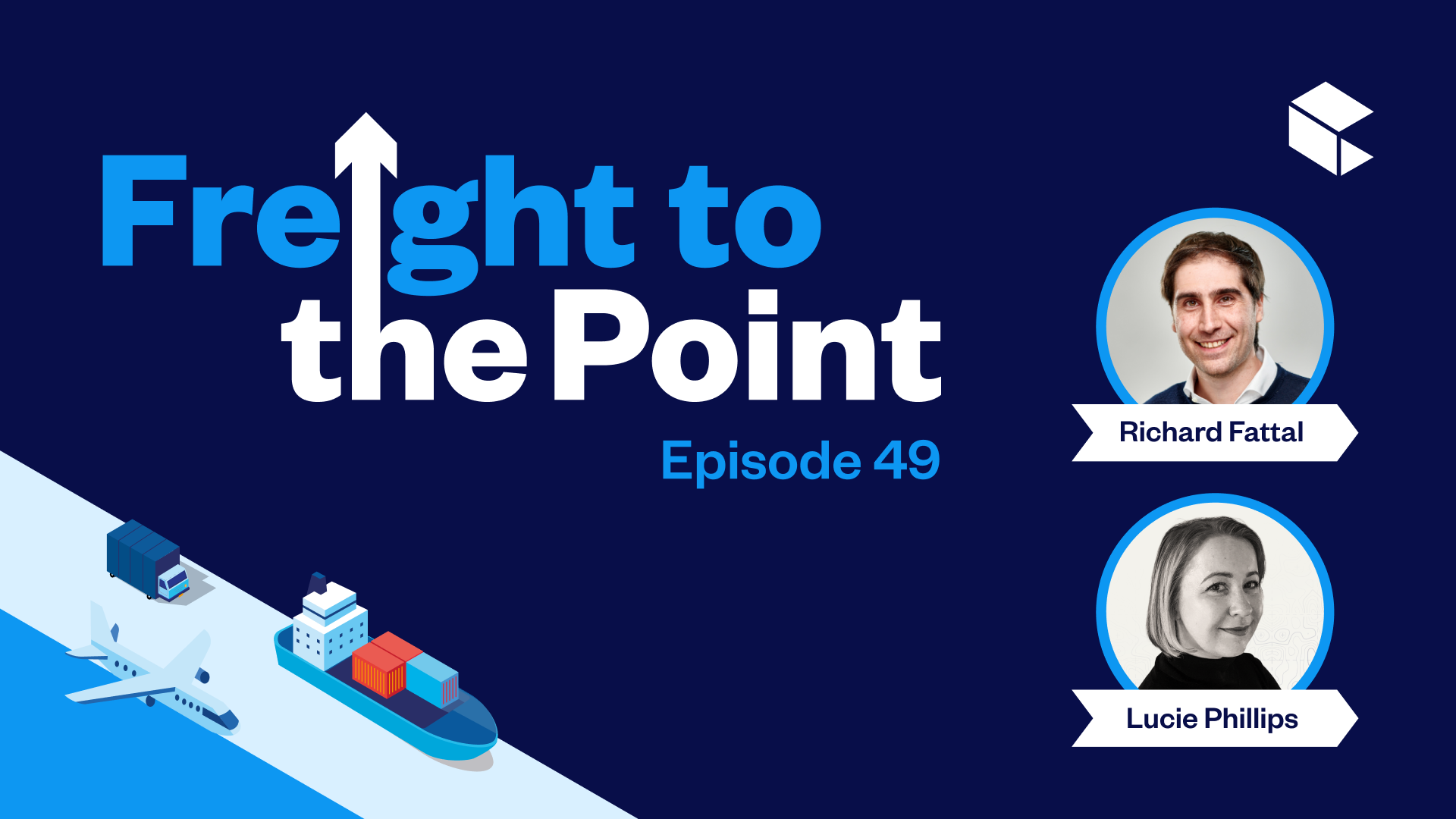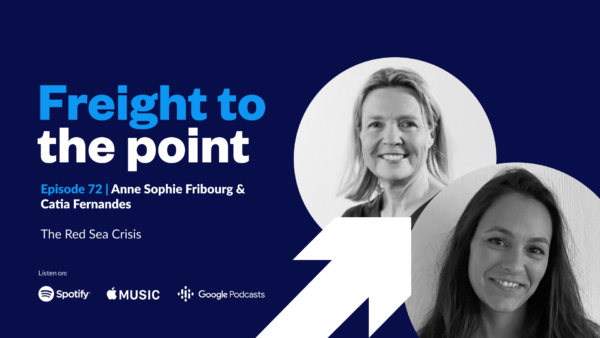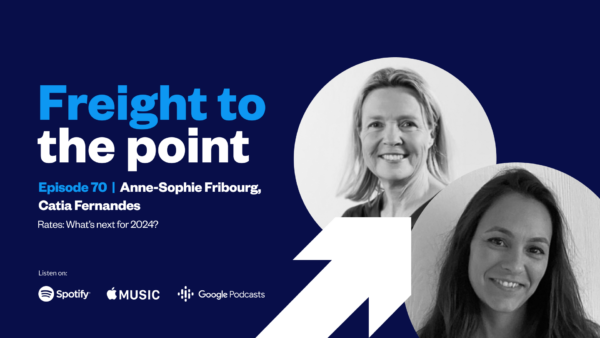Episode 49:
Zencargo's April Ocean Update
See all episodes

Is rate erosion easing? Are shippers leaning on the spot market too much?
This is what we explore in our latest Ocean Update episode as Lucie Phillips and Richard Fattal talk about major events that have happened in the ocean market over the last month.
They discuss:
- Whether rates are bottoming out
- More updates from the 2M sailing schedules
- Industrial action across Europe.
Lucie Phillips
Lucie is an integral part of the Zencargo team, helping with service delivery and setting up Zencargo’s ops team to scale with the right technology and platform. Lucie is Zencargo’s Chief Operations Officer, offering teams key insights to help make ship happen every day.
Richard Fattal
Richard Fattal is Co-Founder and Chief Commercial Officer of Zencargo, the digital freight forwarder enabling organisations to make smarter decisions through real-time data of their supply chain. Based in London, Zencargo helps customers manage their supply chain such as Swoon Furniture and Ribble Cycles.
Resources
Lucie Phillips:
Hi, and welcome to another episode of Freight to the Point. I am Lucie Phillips, Zencargo’s Chief Operations Officer. And today we’ve invited Richard Fattal back on again to talk about what’s happening in the ocean market this month. So, welcome back Richard.
Richard Fattal:
Hi Lucie. Thanks so much for hosting and for having me on.
Lucie Phillips:
Great to chat to you today. Thanks for coming. So, in the last episode in March when you were chatting to Marina, you both talked about three things. So, you talked about how the supply and demand imbalance has dragged down rates. You were talked about the reorganizing of services from the 2M alliances and we also briefly touched on the ILW contract negotiations on the US Wests Coast. So, it’s been nearly a month since that episode. Can you give us some updates on what’s been going on in the market since then?
Richard Fattal:
Thanks so much Lucie. I mean, I think the big question in the market right now is, are the spot rates in the market bottoming out? And it’s an important point in the year because we’re just entering into the typical contract negotiation season on the US trans-Pacific lane. And so, market participants really look at the spot market as an indicator for how those negotiations go. And I would say that the market position, the market rates are very much a reflection of where we are in the restocking cycle. And the big question on everyone’s mind is, are we now starting to see businesses stock up again? What’s going on with the order cycle? And what we see in our surveys of manufacturers and retailers and conversations that we’re having is that generally businesses are reporting that stock levels start to be more in line. Certainly, that’s more the case in Europe that went through the destocking trend a little bit earlier than the US versus catching up a little bit more.
But whilst stock levels are more, let’s say, in the right place right now. What’s not managed to really pick up yet is net new demand from the consumer and demand still seems to be muted given the economic environment. I think this coupled with a tendency of businesses to really pause a new product development. There was a very interesting article this week in the Wall Street Journal talking about how product lines, particularly in consumer products in retail, are down across different products between 5% and 10% over the whole period of the pandemic. Businesses are taking less risk around new product development that all in all leads to less net new demand. So, we’re now in this kind of position where inventories start to kind of look a little bit more normalized. And the big question is when is net new demand going to pick up in line with typical seasonality or not?
But what we have seen practically in the market is that in week 13, the Asian-North Europe component of indices were broadly flat. Asia to the US TP was also steady. So, you’ve had a couple weeks now of steady rates after record losses since the beginning of the year, like record reductions in pricing. The only place where we do see continued reduction in rates is on the transatlantic where I think we’ve seen an 8% to 10% reduction in the rate levels over the past week. This again is from a higher baseline. So, from a higher historical level on the transatlantic. And this was the last of the trades where there’s been for example, niche carriers entering the market and we’ve also seen some of the major carriers allocate more capacity to that loop. So, that’s really the last one to move. But what we are seeing for the moment is steadying out, bottoming out of the rates across the board.
And the question right now is how this is going to read into the long term market. I would say that the bottoming out of the rates is very much kind of a reflection of the proactive behaviour of the carriers over the last, I would say, a week to month or so to continue the blanking program. For instance, the 2M alliance, Maersk and MSC, announced the cancellation of the TP6/Pearl and the TP2/Jaguar sailings from China for the 13th and the 21st of April. And we now have seen blankings up to 50% on the key Asia, Europe and trans-Pacific lanes. So, whilst, I think, I was reporting on the last episode that the level of blank sailings was actually at a rather reduced proportion to the amount of reduction in demand that we’d seen during the big period at the beginning of COVID, we have now seen the carriers react more strongly in terms of their efforts to blank sailings. And that’s why that’s very much followed through in terms of a bottoming out of rates.
Lucie Phillips:
Great, thanks Richard. So, as the drop-in rates is starting to bottom out then what does this mean for shippers?
Richard Fattal:
Thanks, Lucie. I mean, I think it’s really interesting because you have this situation where you’ve been through, let’s say, a record level freight rates over the last couple of years and realigned budgets at the end of last year to having lower freight rates. But likely those budgets have been set at higher levels in the current spot market and a lot of shippers are looking at themselves saying, “What do I do here?” The majority of businesses that we talk to are able to support this level of freight rate and a little bit higher in their budget, but what’s very important to them is stability and given the market environment and given that carriers will need to actively manage capacity, and that means reducing the number of sailings, and that means effectively less certainty to the shipper around lead time. I think it’s very important that you think about your rate procurement and contracting strategy in the context of getting some stability in terms of your purchasing.
And with rates bottoming out, we think it’s increasingly interesting to move into long-term rates, but also to move into long-term rates where you have more than one option given the potential for basically the blank sailings impacting the market and impacting the frequency of sailings that you are able to access particularly on the longer transits out of Asia into Europe and the US. So, our general recommendation is, now is an opportune time to start thinking about longer term contracting but also having a little bit of flexibility in the arrangements that you’ve made as well as leaving a percentage of your business on the spot market just because the nature and fragility of the market.
Lucie Phillips:
Great, thanks for that Richard. So, last time, changing the topic, we talked about the 2M adopting new strategies since announcing their plans split in 2025. And last month, we saw them reorganize some of the services. So, what has happened since then?
Richard Fattal:
Sure. So, after weeks of blanking, the AE1/Shogun Asia-North Europe loop, the 2M has suspended this service. So, that means that they have effectively taken out 12 13,000 to 20,000 TEU vessels. It’s a significant capacity reduction. And the big question is what that means for how the capacity comes back into the market and how the services reemerge. Do they reemerge as independent services? How are the independent 2M services going to start to come back into the market? I think the good news for shippers in terms of the blanking of the AE1/Shogun was that the reliability really wasn’t there. So, in some ways, it’s welcome used to shippers because they can at least understand they’re going to get more reliability from the sailings that are left in the service catalogue. But I think everyone is really looking at what 2M are going to do together and what they’re going to do independently over the coming months.
One thing we have seen is we’ve seen a diversification of the kind of rates approach out of Maersk and MSC. Maersk obviously are very heavily involved in their spot products that they advertise online and they have an ability to kind of dynamically move volume around. MSC work with some of the largest freight and logistics service providers in the world and have slightly different distribution strategies. But we start to see the strategies of the two shipping lines diverge to some extent. And we also have seen this major move on Asia-Europe in terms of service cancellation.
Lucie Phillips:
So, given all that we’ve discussed so far today, then yes or no, will a diversified rate strategy benefit businesses in the near term?
Richard Fattal:
So, I’ll say a 100% yes. I think, as I said before, now is a time to look at longer term contracting. Rates are at what are historically low levels and at the same time you have a market environment where the frequency of blank sailings means you really need to be agile. And so, I would say a diversified strategy that adopts some long-term proportion of your total freight and allows for more agility in terms of service options that are available to you is the right way to go. And I would encourage everyone to engage with their freight provider to really discuss this further. At Zencargo, we do offer kind of one-to-one bespoke freight contracting strategy sessions and please do feel free to reach out and get in touch about this. It’s something that has been very helpful for our customers.
Lucie Phillips:
Great, thank you Richard. And so, lastly for our listeners, is there anything else they need to be aware of in the market right now?
Richard Fattal:
Well, I mean, one of the things that’s cropped up over the last week or so is continued strikes in Europe and I think this is part of the same generalized trend on cost of living across Europe. We’ve seen nationwide strikes in Germany over pay rises and it’s had significant disruption at the airports and at the port of Hamburg. Hamburg is the largest port in Germany and some of the very large vessels were unable to call or depart from the port. So, something certainly to watch out for and if there’s continued industrial action, it’s something that one can look at in terms of alternate port selection within Europe. And then, France has definitely been on our radar over the last few days and weeks where demonstrators protesting against the government’s plan to raise the retirement age have caused quite a lot of disruption to the road freight market. So, we do see industrial action continuing to pose a threat to supply chain stability and I would certainly have your ears wide open to potential disruption and the need to plan around that disruption.
Lucie Phillips:
That’s great. Thank you so much, Richard, and thank you for your time today.
Richard Fattal:
Thanks so much for having me on.
Lucie Phillips:
And thank you again to our listeners for tuning into this episode of Freight to the Point. Don’t forget to like and subscribe to our show and if you do have any feedback on this episode, please do not hesitate to reach out on LinkedIn. But until our next episode then, goodbye.

Episode 72: The Red Sea Crisis
In the latest episode of Freight to the Point, we’ve featured our most rec...

Episode 71: The potential of demand forecasting with artificial intelligence
In the most recent instalment of Freight to the Point, Lucie Phillips, Zen...

Episode 70: Rates: What's next for 2024?
As we prepare for the year ahead, it's crucial to consider the three pillars...

